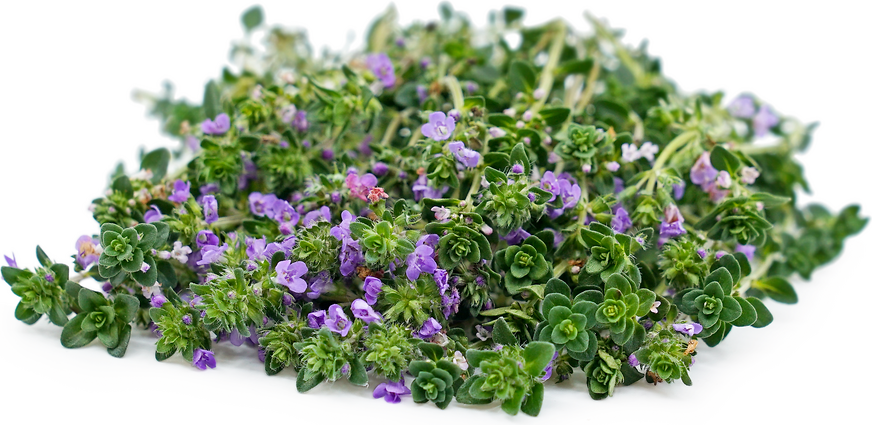


Flowering Thyme
Estimated Inventory, bunch : 0
Description/Taste
Flowering thyme is a mature thyme plant, that has reached the flowering stage. Thyme grows like a small shrub, growing about eight inches in height. The branched and woody stems grow close together, the tops of the stems being more tender than the base. The leaves are very small, only measuring a few millimeters, and grow in clustered pairs at intervals along the stems. The flowers bloom along the stem, nestled in among the leaves. They are often purple, but can be pink or white depending on the variety. The tiny, purple blooms of Flowering thyme offer a balsamic scent and citrusy flavor with hints of mint.
Seasons/Availability
Flowering thyme is available in the early spring and late summer months.
Current Facts
Thyme is a widely used culinary and aromatic herb, that is also grown for its ornamental and edible purple flowers. Botanically known as Thymus vulgaris, thyme is in the mint family. The name ‘Flowering thyme’ is used to describe the plant in full bloom, when it is at its most aromatic; the flavor of the leaves heightened by the presence of the flowers. Thyme doesn’t lose its aroma and flavor once it flowers, as some herbs tend to do. It is said that honey from the nectar of Flowering thyme can rival that of lavender honey.
Nutritional Value
Flowering thyme contains significant amounts of vitamins A and B-complex, as well as minerals like calcium, potassium and magnesium. The mature tops of Flowering thyme contain an essential oil consisting primarily of natural compounds thymol and carvacrol, which give the leaves and blossoms of Flowering thyme their aroma and taste. The herb also contains tannins, bitter compounds, and organic acids, which together with thymol and carvacrol offer digestive benefits, as well as antibiotic, antibacterial and antioxidant properties. Overall, ingesting thyme is believed to be ideal for maintaining good health.
Applications
Thyme is known to cooks as one of the principal ingredients in herbs de Provence, and is also one of the main ingredients in an herb sachet for soups, stocks, and sauces, known as a “bouquet garni.” Flowering thyme can be used not only for these applications, but also for others that require use of the fresh herb. The tiny flowers impart the same flavor as the leaves in any dish and also add a touch of color. Pinch off flowers and leaves to use as a flavorful garnish on salads, soups, or quiches. The flowers are often used to enhance herbed butters or spreads. To store Flowering thyme, keep sprigs wrapped in plastic in the refrigerator for up to a week. Gently rinse under cool water before use. Flowering thyme can be dried and kept in an airtight container for up to six months.
Ethnic/Cultural Info
Throughout history, thyme has been used by different cultures for things unrelated to food. The name “thyme” in its Greek form, meant ‘to fumigate,’ as the herb was often burned as an insect and ‘other venomous creature’ repellent. In ancient Rome, thyme was used to treat melancholy and during Medieval times was thought to instill vigor and courage in the user. The flowering tops of thyme are harvested for the essential oils they contain. The compounds in the oil give the plant antibacterial, fungicidal, and antiseptic qualities that translate well into natural applications for deodorant, mouthwash, soaps and toothpastes. The flowers are often used in potpourri or herb sachets for closets and drawers.
Geography/History
Flowering thyme is native to the countries bordering the Mediterranean, Southern France, Italy, and Spain. Wild thyme was first classified by Carl Linnaeus as Thymus serpyllum and the variety known today as “garden thyme” is likely descended from it. Altogether, there are over 30 varieties of thyme. Spread over Europe by explorers, travelers and armies, thyme was commonly cultivated in England by the mid-16th century. Thyme was spread to the Americas by explorers and is now considered native in the coastal United States and Canada by the USDA. Over the centuries, the herb has been introduced in many of the temperate climates around the world. The herb is evergreen and grows as a perennial, withstanding a wide range of temperatures.
Recipe Ideas
Recipes that include Flowering Thyme. One
| mindful mocktail |
|
Decorative Ice Cubes |
| KCET |
|
Flowering Thyme Liqueur |
| LA Times Culinary SOS |
|
Thyme Flower And Goat Cheese Tart |
| look what i made |
|
HOMEMADE FLOWER SALT. |









